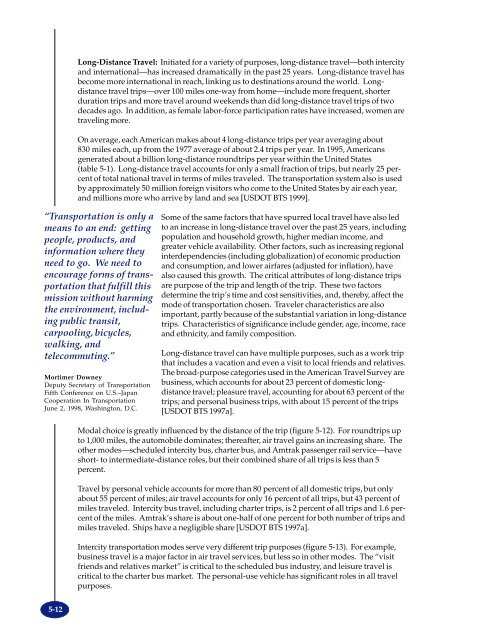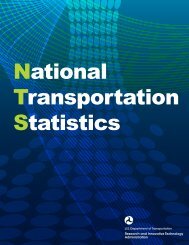TRANSPORTATION - BTS - Bureau of Transportation Statistics
TRANSPORTATION - BTS - Bureau of Transportation Statistics
TRANSPORTATION - BTS - Bureau of Transportation Statistics
Create successful ePaper yourself
Turn your PDF publications into a flip-book with our unique Google optimized e-Paper software.
Long-Distance Travel: Initiated for a variety <strong>of</strong> purposes, long-distance travel—both intercityand international—has increased dramatically in the past 25 years. Long-distance travel hasbecome more international in reach, linking us to destinations around the world. Longdistancetravel trips—over 100 miles one-way from home—include more frequent, shorterduration trips and more travel around weekends than did long-distance travel trips <strong>of</strong> twodecades ago. In addition, as female labor-force participation rates have increased, women aretraveling more.On average, each American makes about 4 long-distance trips per year averaging about830 miles each, up from the 1977 average <strong>of</strong> about 2.4 trips per year. In 1995, Americansgenerated about a billion long-distance roundtrips per year within the United States(table 5-1). Long-distance travel accounts for only a small fraction <strong>of</strong> trips, but nearly 25 percent<strong>of</strong> total national travel in terms <strong>of</strong> miles traveled. The transportation system also is usedby approximately 50 million foreign visitors who come to the United States by air each year,and millions more who arrive by land and sea [USDOT <strong>BTS</strong> 1999].“<strong>Transportation</strong> is only ameans to an end: gettingpeople, products, andinformation where theyneed to go. We need toencourage forms <strong>of</strong> transportationthat fulfill thismission without harmingthe environment, includingpublic transit,carpooling, bicycles,walking, andtelecommuting.”Mortimer DowneyDeputy Secretary <strong>of</strong> <strong>Transportation</strong>Fifth Conference on U.S.–JapanCooperation In <strong>Transportation</strong>June 2, 1998, Washington, D.C.Some <strong>of</strong> the same factors that have spurred local travel have also ledto an increase in long-distance travel over the past 25 years, includingpopulation and household growth, higher median income, andgreater vehicle availability. Other factors, such as increasing regionalinterdependencies (including globalization) <strong>of</strong> economic productionand consumption, and lower airfares (adjusted for inflation), havealso caused this growth. The critical attributes <strong>of</strong> long-distance tripsare purpose <strong>of</strong> the trip and length <strong>of</strong> the trip. These two factorsdetermine the trip’s time and cost sensitivities, and, thereby, affect themode <strong>of</strong> transportation chosen. Traveler characteristics are alsoimportant, partly because <strong>of</strong> the substantial variation in long-distancetrips. Characteristics <strong>of</strong> significance include gender, age, income, raceand ethnicity, and family composition.Long-distance travel can have multiple purposes, such as a work tripthat includes a vacation and even a visit to local friends and relatives.The broad-purpose categories used in the American Travel Survey arebusiness, which accounts for about 23 percent <strong>of</strong> domestic longdistancetravel; pleasure travel, accounting for about 63 percent <strong>of</strong> thetrips; and personal business trips, with about 15 percent <strong>of</strong> the trips[USDOT <strong>BTS</strong> 1997a].Modal choice is greatly influenced by the distance <strong>of</strong> the trip (figure 5-12). For roundtrips upto 1,000 miles, the automobile dominates; thereafter, air travel gains an increasing share. Theother modes—scheduled intercity bus, charter bus, and Amtrak passenger rail service—haveshort- to intermediate-distance roles, but their combined share <strong>of</strong> all trips is less than 5percent.Travel by personal vehicle accounts for more than 80 percent <strong>of</strong> all domestic trips, but onlyabout 55 percent <strong>of</strong> miles; air travel accounts for only 16 percent <strong>of</strong> all trips, but 43 percent <strong>of</strong>miles traveled. Intercity bus travel, including charter trips, is 2 percent <strong>of</strong> all trips and 1.6 percent<strong>of</strong> the miles. Amtrak’s share is about one-half <strong>of</strong> one percent for both number <strong>of</strong> trips andmiles traveled. Ships have a negligible share [USDOT <strong>BTS</strong> 1997a].Intercity transportation modes serve very different trip purposes (figure 5-13). For example,business travel is a major factor in air travel services, but less so in other modes. The “visitfriends and relatives market” is critical to the scheduled bus industry, and leisure travel iscritical to the charter bus market. The personal-use vehicle has significant roles in all travelpurposes.5-12
















